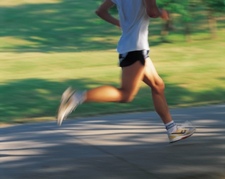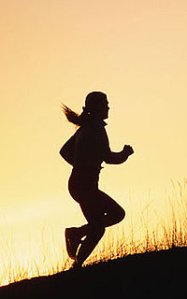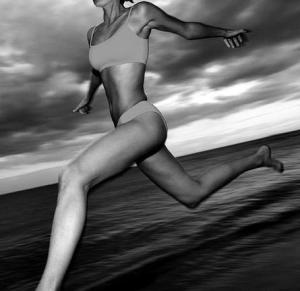When I first decided to start running, it was because I’d reached my goal of losing 100 pounds and I was feeling “lost.” I needed a “goal” and something to work towards to keep me motivated. I decided, “I’ll train for a 5k.”
I really had no idea what running was, or how to train. I just started running. I foolishly thought running meant Run As Fast As You Can. Um, no. That’s not running! Michael gave me a Polar Heart Rate Monitor for my birthday a few years ago and that really opened my eyes! I’d been doing it ALL wrong. I started to really figure it out. I realized that my goal should be to stay within the range for age, sex, weight, etc. I started to run differently and it made all the difference in the world.
I’ve mentioned previously that Heart Rate Monitors are wonderful things. I think everyone that works out should get one–even if you’re not a runner. It works well for swimmers, bikers, everything. I wear mine hiking! And don’t be intimidated by the insane cost of a Garmin. While they are fancy and fun, you don’t need something like that if you’re just starting out. My Polar was about $100 and works great for what I need: my heart beat range and calories. Now that I’m more into running and training for events, I’d love to have a Garmin to give me more detailed information.
That being said, learning how to run the right way made all the difference in the world. And if you’re new to running, I have more tips.
I finally finished reading “Fast Track” by Suzy Favor Hamilton. I posted about it previously in regards to Over-training. I’ve accumulated some excellent info, some of it is copied right out of the book, but I tried to summarize the best I could. 🙂
Here are a few tips she had for training:
The Importance of each Training Phase [pg 217]
1. BASE PHASE: prepares you body for what comes next. You need to have a strong base of mileage runs to sustain you through a long, intense year of training. Increase mileage 5-10% each week.
2. CONDITIONING PHASE: you are conditioning your body to perform at a higher level. Start adding speed or track workouts to your routine 1-2 times a week. You are conditioning your body to maintain a faster pace.
3. COMPETITION PHASE: your mileage will decrease as you get closer to the race. Taper training, give your body and mind time to rest, and recuperate. But not so much that you lose your fitness.
4. RECOVERY PHASE: give your body the TLC it needs to recover. Without proper recovery, you risk burnout, injury and over-training. Rest 1-2 weeks, or switch to cross-training or easy runs.
 She gives more tips on how to “fast track” your workouts:
She gives more tips on how to “fast track” your workouts:
1. Downhill running: will improve your leg turnover, but unless you have a good base to begin with, don’t attempt this. Warning: it can take quite a toll on your quads. [pg 219]
2. Fartlek: also known as “speed play.” 3-6 total miles of surges of various lengths and speeds. Do over varied terrain.
3. Hill Repeats: do during your “conditioning” phase. This improves leg strength. Use uphill for intense part of workout and downhill as recovery.
4. Intervals: repeated surges of 200 meters or longer followed by recovery intervals. Improves speed and lactate threshold. Do this during conditioning and competition phases.
5. Speed endurance: for the condition/competition phases. Run at a RACE pace or faster for 200-1600 meters, taking a full recovery after each repeat. Example: do three 600-meter runs with 8-10 minute recovery.
6. Speedwork: do short, intense sprints of 5-150 meters, taking a full recovery after the repeats. Example: three 50-meter sprints with 3 minute recovery.
7. Tempo Running: run at a pace 10-30 second per mile slower than your current 10k race pace for a distance of 2-4 miles.
8. Tempo Intervals: run 400 meter to 2-mile repeats with short recovery of 30-120 seconds. Total distance run should equal 2-4 miles.
9. Cross-Training: aqua running, biking, elliptical, cross-country skiing. Helps minimize injuries and adds variety to workouts.
10. Form Drills: improves leg turnover. The more efficient your stride, the faster you run. Basic drills = high knees, buttkicks, skipping, grapevines, backward running.
I started reading “How to be an Adult in Relationships” by David Richo. I came across a quote in there that I wanted to share. I feel like it can be applied to any situation–including losing weight! Yesterday I wrote about in your face wake up calls and how we have to want to make a change. I think this quote speaks to that too:
“As a war hero Tom Daly said, ‘Often, the events we regard as our deepest wounds are in fact initiations that break us out of the unhealthy enchantment of innocence, grandiosity, passivity, violence or addiction.’ We need such initiations, for without them we may resist growth and change or even deny our responsibility toward others and our destiny to transcend personal ego.” [pg 67]
QUESTION: Are you a runner? What are your training goals?



Angela
I’m not a runner… yet. I’m coming so close though, sometimes I just feel like I’m about to start running only I don’t. I’m under medical advisement to not start running right now.. it’s frustrating but hopefully that’ll all be fixed by the end of the summer.
I’m considering doing a couch to 5k program once I’m healed up and cleared to start running. I would love to run a 5k yet this year, if I can. Thanks for this post, the information is great!
I’m also considering getting a heart rate monitor but just now started looking at all the models/options, etc. Overwhelming at first!
hundredtenpounds
It can be very overwhelming. I highly suggest Newbies get the Polar. It’s less “stuff” and less “techie” and it’s more affordable. Perfect for beginners!
Angela
Yea, I’ve been trying to make a list of what I expect from/want in a heart rate monitor. Right now my basic want is to just track calories burned and sometimes check my heart rate. My phone and bike computer handle most everything else I’m looking for at the moment. My master plan is to wait until my birthday and drop a lot of not subtle hints.. 🙂
Kelly
YES. I am a runner (even though I have a hard time calling myself a runner) and I am running the NYC Marathon in November that I qualified for back in January. I am hoping to BQ (Boston Qualify) at that race and the run Boston in April. If I can do those 2 iconic races (via qualification) I honestly think I would hang up my marathon shoes and focus more on half marathons and 10K’s. Here’s hoping…
Candice
This is great, and it motivated me to break out my heartrate monitor and figure out how to use it. I can’t think of a better time to run the right way than while marathon training!
lisasfoods
I feel proud to say that I am a runner. I always wanted to be one in high school, but could barely run a mile. Now I’m readying for my first 5k tomorrow, and feel pretty excited (and nervous, of course).
hundredtenpounds
Good luck tomorrow! You’ll do great! 🙂